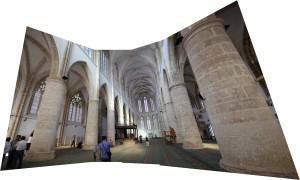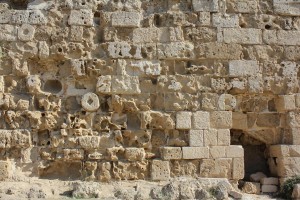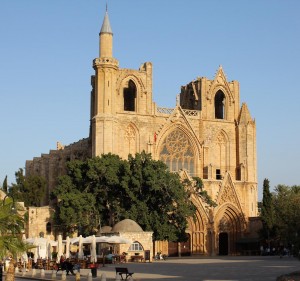Opposite Perspectives
October 23rd, 2011

I used Photoshop to merge four photos of the theater in ancient Salamis. Then I used the Content Aware Fill function to supply the missing section of sky produced by the photo stitch. I don't understand the computer's perspective on why it filled in the sky with theater seating. Am I having a vision?
On Saturday, we drove east and found our way (finally) to the border crossing. You have to want to find the crossings. They are not marked with road signs. But we finally made our way to Famagusta. Oh, wait. The Turks renamed it Gazimağusa.
One of the many things that infuriate Greek Cypriots is the way Turkish Cypriots have renamed most towns of the island. We consider the person to whom we are speaking before we select which name of a town to use. One person’s hero is another person’s terrorist.
Greek Cypriots use many disparaging terms to describe the invasion of north Cyprus by the Turkish army in 1974. Turkish Cypriots refer to the same operation as a peace-keeping mission. If you read Greek publications, 1974 was a murderous conquest and a grotesque perversion of justice. Turkish publications focus on the murderous actions of Greek nationalists and use words like ethnic cleansing to describe activities leading up to 1974. You can see such language on web sites posted by the different sides. Here, for example, is one by a Turkish tourism organization. http://www.kyreniamountaintrail.org/trnc.htm
The TRNC flag is a modified version of the Turkish flag. Here is what a Greek website says about it. http://www.cyprusflag.net/trnc-flag.html
Selective Memories
People have selective memories and typically fail to consider or to mention offensive behavior by their own side. We listen sensitively to the stories, mostly from Greek Cypriots, because we primarily interact with them. But last Wednesday, while we were having lunch in Kyrenia (or is it Girne?), a large-screen TV continuously broadcast news of 18 Turkish soldiers murdered by Kurdish “terrorists” in eastern Turkey. The café employees were glued to the news and had much to say about the Kurds. Since then, Turkey has invaded western Iraq and killed over 40 of the “terrorists.” I have not heard the Kurdish version of events. I think I know approximately what they would say about the long history of Turkish oppression of the Kurds. Perspectives differ.
As I have said before, everything in Cyprus is political. Yet Lynne and I just wanted to see the archaeological site of ancient Salamis, the capital of Cyprus before massive earthquakes in the fourth century A.D. decimated the city. The Emperor Constantius rebuilt the city and renamed it Constantia. But silt from the adjacent river progressively made the harbor less important, and Arab raids in the seventh century finished off Salamis/Constantia. So the replacement city of Famagusta was built seven kilometers to the south.

City pride?? A collection of junk tires at the base of the fortification wall, just below the west side of the Citadel. This photo does not adequately show how bad they look
Archaeological excavation of Salamis ceased in 1974. Various archaeologists have told me that they simply cannot do any work in the north—no matter how significant the site. If they did, they would lose their permission from the Republic of Cyprus to conduct work on the island. They will not risk their careers. Meanwhile, Turkish Cypriots make modest efforts funded by admission fees just to maintain sites like Salamis.
To the victors go the spoils.
Prior to 1974, Famagusta (or is it Gazimağusa?) was one of the most thriving cities on the island. No longer. Tourists pump money into the economy, but compared with Nicosia, it is impoverished. The Venetian wall around the old city is imposing. We entered St. Nicholas Cathedral, an impressive Gothic structure built between 1298 and 312. Now it is the Mosque of Mustafa Pasha, named after the Turkish commander who conquered Famagusta in 1571, after a 13-month siege. He so hated the skilled resistance of the Venetian commander, Marco Antonio Bragadin, that he had the man hideously tortured—although he promised prior to Bragadin’s surrender that he would allow the safe passage of Famagusta’s inhabitants to Crete.
Initially, the evacuation proceeded smoothly, but during the ceremony when Bragadin officially surrendered the city, Mustafa Pasha pulled his knife and cut off the man’s right ear. He then had his soldiers cut off the left ear and nose. Bragadin was dragged around the city, hoisted on the yardarm of a ship and abused by sailors, and finally tied to a column in the city center where he was flayed alive. His body was quartered and the pieces distributed as war trophies. And all of the remaining Christians in Famagusta were massacred.

Somehow, the warped perspective produce by merging four photos of the interior of the Gothic Church of St. Nicholas (now Mustafa Pasha Mosque) seems appropriate. I include this photo stitch for my artistic friends.
Entering the Mosque named in honor of the hero Mustafa Pasha is therefore a bit eerie. The once magnificent Gothic Cathedral of St. Nicholas only hints at its former glory. Nearby, the Sinan Pasha Mosque, formerly the Gothic church of Saints Peter and Paul (built c. 1360), is a somewhat sad looking public library. The Citadel (aka Othello’s Tower) is paltry compared with the fortress in Kyrenia (Girne).
Concluding Reflection
Here is a little tidbit about the Nestorian Church in Famagusta. “Syrian merchant Francis Lakhas built this church in 1338 for Famagusta’s Syrian community…. Later, the church was taken over by Greek Cypriots and renamed Agios Georgios Exorinos. The word exorinos means ‘exiler.’ Greeks believe that dust taken from the church floor and sprinkled in the house of an enemy will make him die or leave the island within a year” (G. and M. Micula, Cyprus [London: DK Publishing, 2010], p. 137). Interesting to have a saint with such a function.

Crumbling walls. Note how the limestone blocks in this wall at Salamis are terribly eroded. Also notice the ends of several column fragments, which are recycled pieces from a building destroyed before this one was built. Hear then the parable.
Being in Cyprus is a constant reminder of the lasting impact of the brutality of people toward other ethnic or religious groups. Human history is a sad tale in this regard. I cannot think of a continent where the devastation of conquest has not scarred populations of people. And I shudder at how often the conquering armies celebrate the help of Jesus or Mohammad or Zeus or whomever, to massacre the people whose lands they want.
Posted in Uncategorized | 2 Comments »



October 23rd, 2011 at 12:39 pm
And isn’t this true of all cultures? Ask me what is going on in our country, and you’ll hear the perspective of a very conservative elderly woman, through her eyes and memory of 70 years of history. (Of course, I’m very objective, so I try not to be biased! ): )
October 25th, 2011 at 4:36 am
Thanks for the interesting info and insight regarding perspective. I imagined you and Lynn in some pretty tense (fictitious?) situations, getting mixed up, backtracking over the names:
“Which way to Famagusta? Wait, I mean Gazimagusta…Famagusa…Oh, never mind.”
Your photo of the Cathedral of Santa / Mosque of Mustafa Pasha looks like something out of Lord of the Rings.